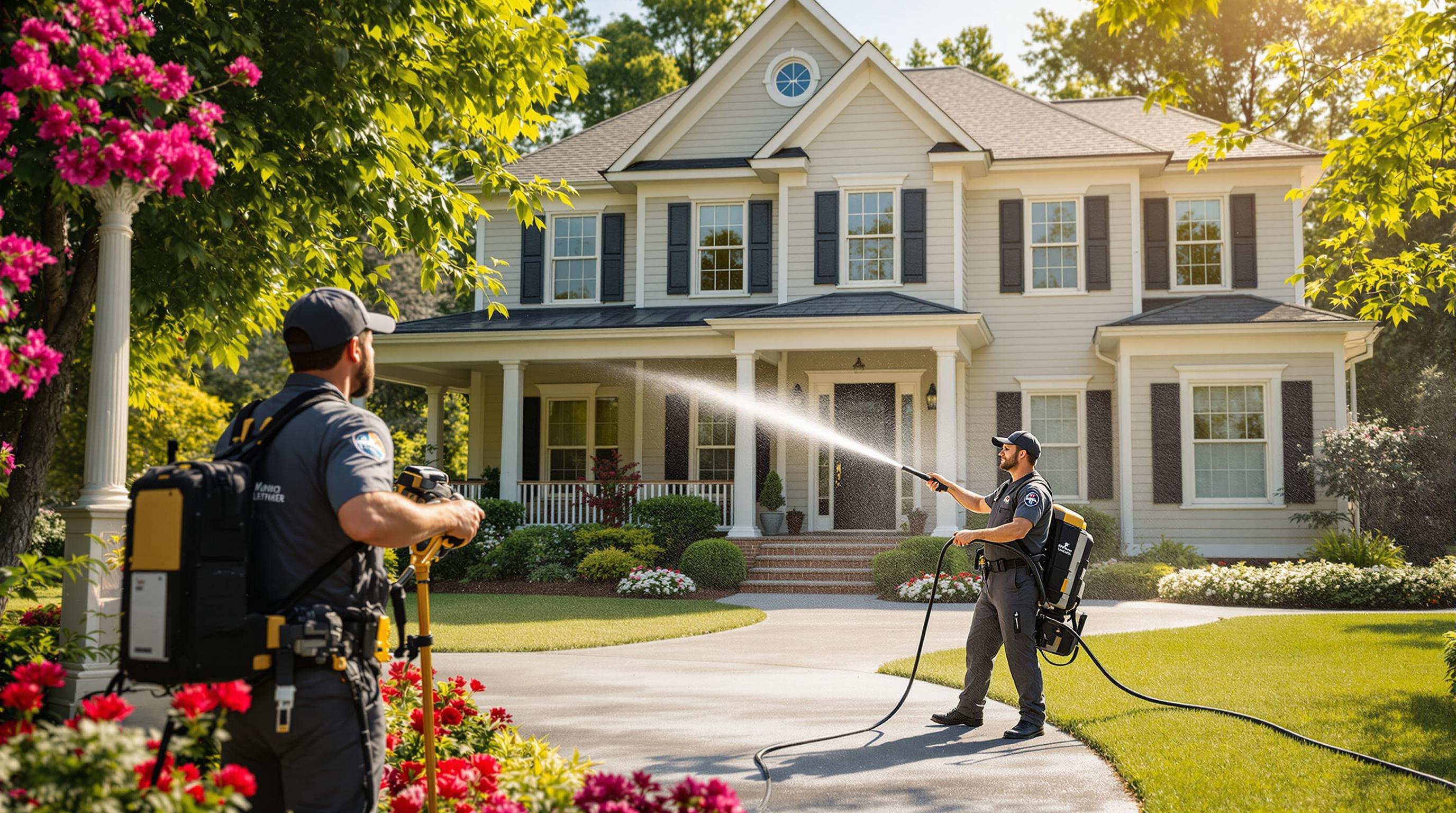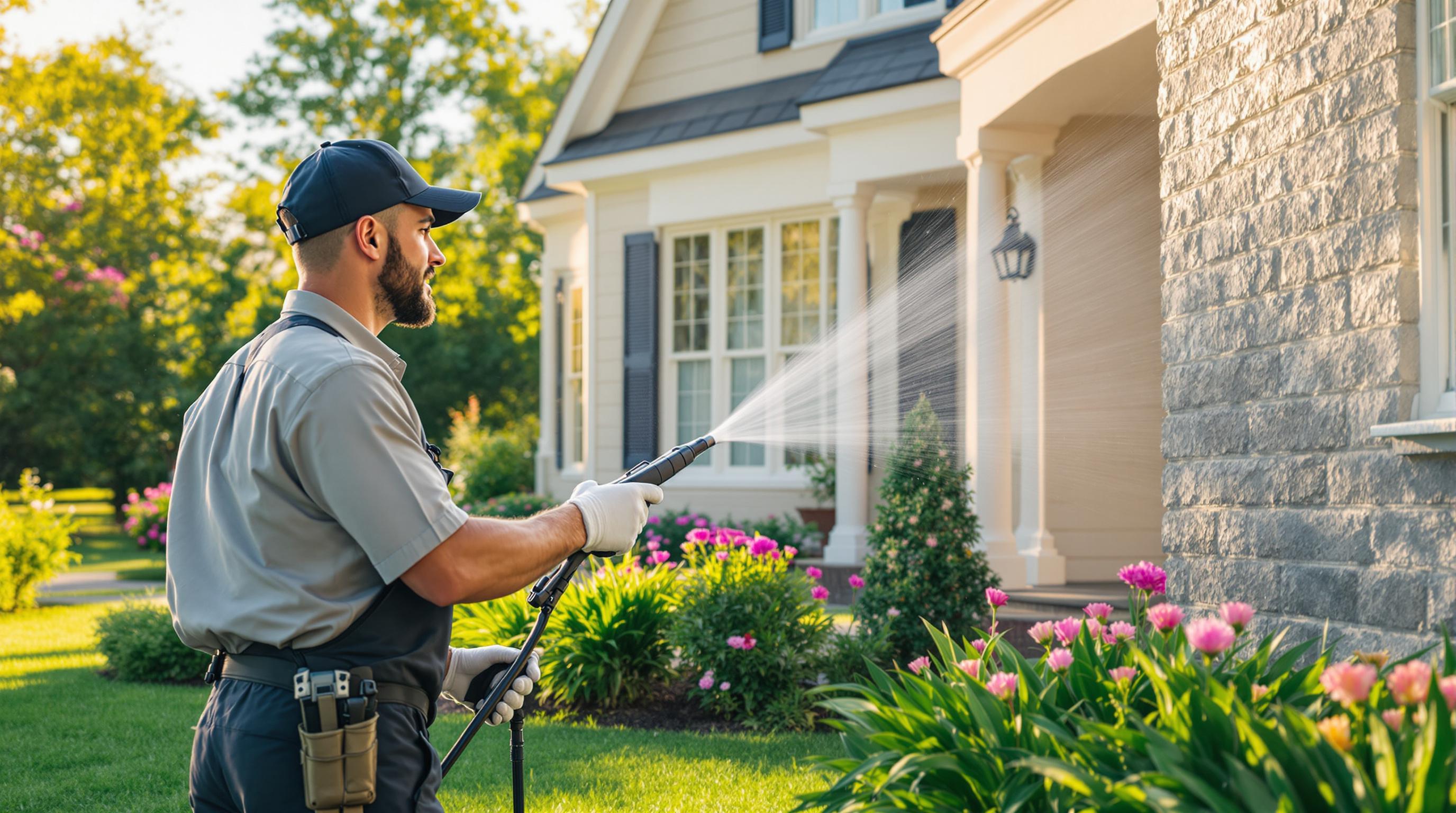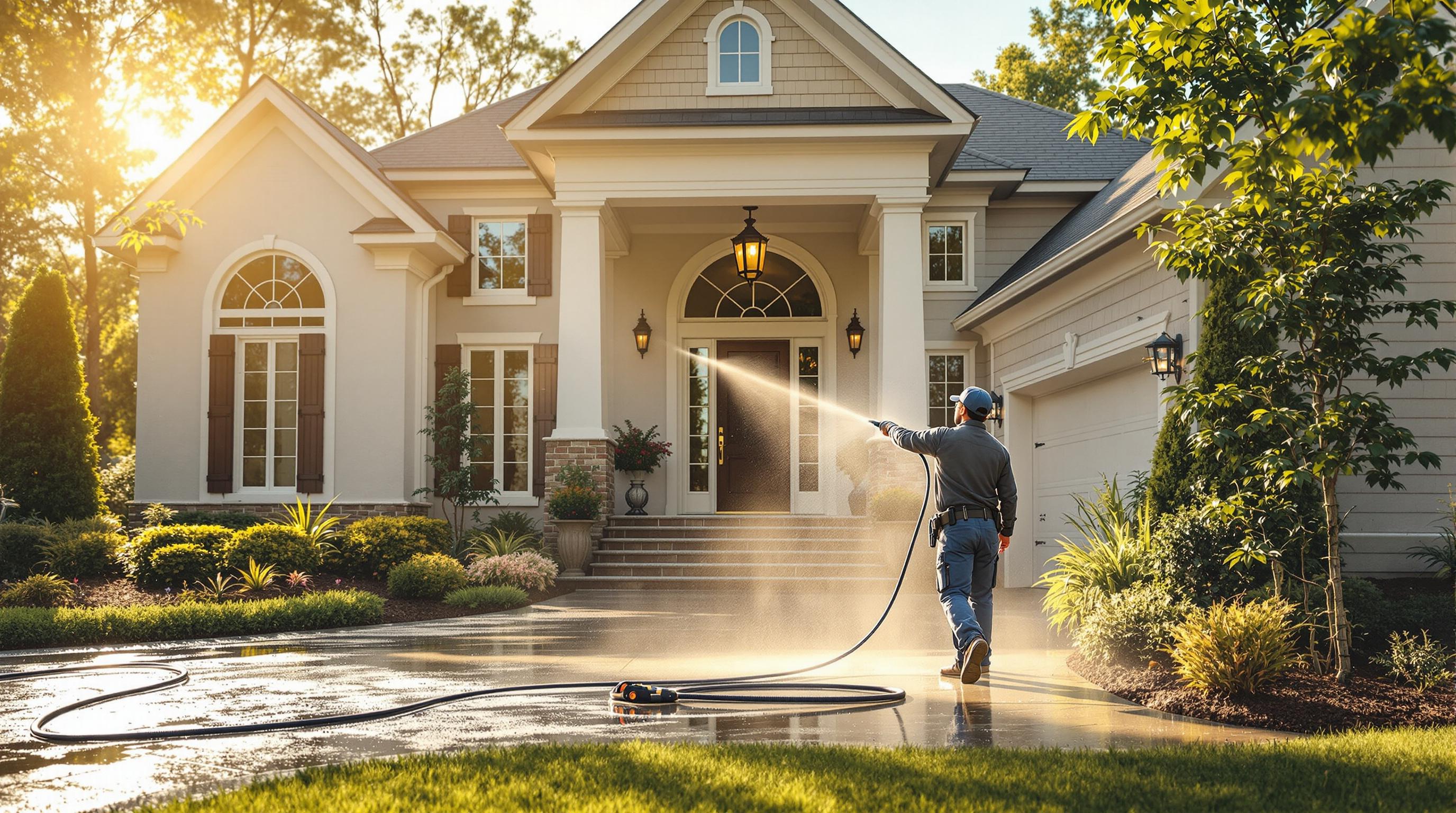Pressure washing in extreme weather requires special techniques to ensure safety, protect equipment, and achieve effective cleaning results.
Here’s what you need to know for hot, cold, and rainy conditions:
-
Hot Weather (95°F+):
- Clean early or late to avoid midday heat.
- Cool surfaces first to prevent damage.
- Stay hydrated and protect equipment from overheating.
-
Cold Weather (Below 32°F):
- Use heated water to prevent freezing.
- Store and drain equipment properly.
- Wear insulated gear and watch for ice hazards.
-
Rainy Weather:
- Use GFCI-protected outlets to avoid electrical risks.
- Wear slip-resistant boots and waterproof gear.
- Light rain can help loosen dirt but avoid heavy downpours.
Quick Tip: Always adjust your methods based on weather conditions to ensure safety and efficiency.
| Weather Condition | Key Adjustments | Safety Focus |
|---|---|---|
| Hot Weather | Cool surfaces, work early | Stay hydrated, prevent overheating |
| Cold Weather | Use heated water, drain equipment | Avoid freezing, wear insulated gear |
| Rainy Weather | Adjust pressure, use waterproof gear | Prevent slips, ensure electrical safety |
These tips help you clean effectively while protecting surfaces, equipment, and yourself in any weather.
How to Power Wash in the Winter | Tips and Tricks for ...
Hot Weather Pressure Washing
Challenges of Hot Weather
Pressure washing in extreme heat comes with its own set of hurdles. High temperatures make cleaning agents evaporate quickly, leaving behind streaks and residue. The heat also puts extra stress on your equipment, leading to overheating and reduced efficiency. To overcome these issues, you'll need to adjust your cleaning approach.
Tips for Hot Weather Cleaning
- Start early: Begin your work in the morning when surfaces are cooler.
- Work in smaller sections: This helps keep areas moist and prevents cleaning agents from drying out too fast.
- Adjust techniques: Tweak your equipment settings to account for rapid evaporation and temperature changes.
Staying Safe in the Heat
Safety is just as important as technique. Make sure to:
- Drink plenty of water and take breaks in shaded or air-conditioned spots.
- Wear lightweight, breathable clothing and UV-protective eyewear.
- Keep your equipment out of direct sunlight when not in use and allow it to cool down during long jobs.
Cold Weather Pressure Washing
Challenges of Cold Weather
Pressure washing during freezing temperatures comes with its own set of hurdles. Water can freeze inside your equipment or on the surfaces you're cleaning. This can lead to damaged hoses, pump parts, and other components. Plus, icy surfaces can create hazardous conditions, increasing the risk of slips and falls.
Tips for Cold Weather Pressure Washing
Here are some steps to help you navigate these challenges:
- Use warm water to minimize the chance of freezing.
- Preheat surfaces to prevent ice from forming.
- Store your equipment in a heated space when not in use.
- Completely drain your system after each session.
These adjustments can protect your equipment and make the cleaning process safer.
Protecting Equipment and Surfaces
Taking extra precautions can help avoid damage in freezing weather. Keep these tips in mind:
- Test a small section of the surface first to ensure it can handle the cleaning process in cold conditions.
- Pay attention to the forecast and schedule your cleaning for times when temperatures are above freezing.
sbb-itb-8e2a680
Pressure Washing in Rain
Risks of Working in the Rain
Using electrical tools in wet conditions requires extra care. The main risks of pressure washing in the rain include poor visibility, slippery surfaces, and electrical hazards. Moisture can get into electrical connections, creating dangerous situations, especially when using extension cords or outdoor outlets.
Rainwater can also dilute cleaning solutions and lead to uneven results, often requiring more passes to get the job done. Despite these challenges, light rain can sometimes be helpful during cleaning.
How Light Rain Can Help
Light rain can make pressure washing more effective in some cases. The natural moisture on surfaces helps loosen dirt and grime, speeding up the cleaning process. This can be especially useful for:
- Dirty concrete surfaces that need extra attention
- Areas with stubborn organic buildup, like moss or algae
- Deep stains that are hard to remove
Maintain at least a 12-inch distance from the surface to ensure you have enough control and visibility while working.
Staying Safe in Wet Conditions
If you need to pressure wash in the rain, follow these safety tips to avoid accidents and protect your equipment:
-
Electrical Safety
- Use outlets with GFCI protection.
- Keep power cords elevated and shielded from water.
- Check cords for any signs of wear or damage before starting.
-
Personal Safety
- Wear slip-resistant boots to prevent falls.
- Use rain gear that keeps you dry but allows easy movement.
- Opt for anti-fog safety goggles for clear vision.
-
Protect Your Equipment
- Shield the pressure washer motor from rain.
- Store cleaning solutions in waterproof containers.
- Keep equipment in a covered area during breaks.
Keep an eye on the weather while working. If there’s thunder, lightning, or heavy rain that reduces visibility, stop immediately and find shelter. Resume only when conditions improve, and it’s safe to continue.
Whenever possible, plan jobs for clear weather. If rain can’t be avoided, these precautions will help you stay safe and get the job done effectively.
Weather Safety Guidelines
Required Safety Gear
Make sure to use appropriate safety gear for different weather conditions to protect operators effectively:
Hot Weather Gear
- Lightweight, breathable clothing
- UV-resistant safety glasses with side shields
- Wide-brimmed hat with neck protection
- Ventilated, non-slip work boots
- Cooling neck wraps
- Waterproof sunscreen with SPF 30 or higher
Cold Weather Gear
- Insulated, waterproof work gloves
- Thermal base layers
- Water-resistant winter boots
- Insulated coveralls
- Anti-fog goggles
- Thermal face coverings
- Heated storage for gear
Wet Weather Gear
- High-visibility rain gear
- Rubber boots with strong traction
- Waterproof grip gloves
- Anti-fog face shields
- Waterproof pouches for tools
- Ground Fault Circuit Interrupter (GFCI) protection devices
Weather Equipment Care
Proper maintenance of equipment in extreme weather ensures safety and efficiency:
Temperature Management
- Store equipment at temperatures above 40°F and allow a 5-minute warm-up in cold weather.
- Keep equipment shaded during hot conditions.
- Monitor water temperatures to avoid overheating.
Moisture Protection
- Shield electrical connections with weatherproof covers and apply corrosion inhibitors to metal parts weekly.
- Use marine-grade extension cords for added durability.
- Store equipment in climate-controlled spaces when possible.
Regular Maintenance Schedule
- Inspect hoses daily for weather-related damage.
- Check seals and O-rings monthly.
- Test pressure relief valves before each use.
- Clean and thoroughly dry equipment after each use.
- Replace worn weather stripping every three months.
Keeping equipment in good condition is just as important as personal safety gear for a secure work environment.
Job Site Safety Steps
Once you’ve geared up and maintained equipment, follow these steps to prepare your worksite:
- Site Assessment
Evaluate the site with weather conditions in mind:
- Measure surface temperatures.
- Spot and address slip hazards.
- Clearly mark areas prone to ice.
- Test ground stability to ensure safety.
- Equipment Setup
Set up a weather-ready workspace:
- Create a 10-foot safety perimeter.
- Use portable shelters to protect equipment.
- Install proper lighting for low-visibility situations.
- Lay down temporary non-slip mats where needed.
- Emergency Preparations
Equip the site with essential emergency resources:
- A fully stocked first aid kit
- Backup power sources
- Weather monitoring tools
- Emergency contact lists
- An evacuation map
- Communication Protocol
Ensure clear and effective communication among team members:
- Monitor weather alerts regularly.
- Use hand signals in noisy environments.
- Conduct frequent safety check-ins.
- Establish emergency stop procedures.
- Coordinate team efforts to handle challenges efficiently.
Conclusion
Safety and Method Review
When it comes to pressure washing in tough weather conditions, following the right techniques and safety measures is crucial. This prevents equipment issues like freezing or overheating and ensures operators stay safe and effective. Wearing the right protective gear also plays a big role in maintaining efficiency.
| Weather Condition | Key Techniques | Important Safety Measures |
|---|---|---|
| Hot Weather | Cool surfaces, work in shaded areas | Stay hydrated, use cooling strategies |
| Cold Weather | Pre-warm equipment, use heated water | Prevent freezing, wear insulated gear |
| Wet Weather | Check electrical components | Use non-slip gear, waterproof equipment |
These guidelines highlight the importance of proper methods to handle weather-specific challenges.
Why Choose Professional Services?
Hiring professionals for pressure washing in extreme weather offers clear advantages. Companies like Pressure Washing Cary NC have the expertise, tools, and experience needed to handle any weather-related challenges. Their insured team uses specialized gear and precise techniques to protect equipment, adjust pressure properly, and achieve excellent cleaning results. Relying on professional services ensures consistent, top-notch cleaning no matter the weather.


